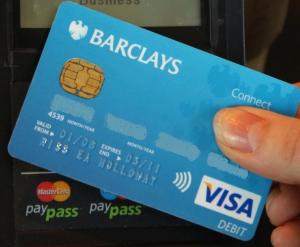Contactless Bank Cards Forecasted To Continue Strong Growth in 2011

Shipments of contactless bank payment cards will grow by almost 30% in 2011, following a nearly 50% jump in 2010, as the U.S. market recovers and banks in Europe and Asia ship more dual-interface cards, according to vendor group Eurosmart.
At the same time, 2011 will see the first significant quantities of NFC-enabled SIM cards shipped–with 15 million NFC "secure elements" projected for the year, said Eurosmart.
And secure contactless transit and ID cards or documents also are showing impressive gains. All told, contactless shipments across all market segments, including banking, hit an estimated 370 million units in 2010, which is above Eurosmart’s earlier forecasts for the year. The vendor organization predicts that contactless shipments will reach 475 million units in 2011.
The vendor group, made up mostly of smart card and chip suppliers, projected that the industry would ship 225 million contactless payment cards in 2011, compared with 175 million in 2010. The 2010 shipments were up by 46% from a lackluster 2009 market. Most of the cards carry a Visa payWave or MasterCard Worldwide PayPass application.
The group, which includes smart card vendors Gemalto and Oberthur Technologies, both based in France, and Giesecke & Devrient of Germany, noted that the growth rate for dual-interface bank cards is exceeding that of pure contactless bank cards. Dual-interface payment cards, which support the EMV standard, are mainly issued outside of the United States. On the other hand, contactless credit and debit cards shipped to U.S. banks and those in a small number of other countries, do not have a contact interface because they do not support the more-secure EMV standard. But these contactless chip cards also are growing and would have accounted for more total contactless cards than dual-interface in 2010.
Eurosmart did not break out shipment forecasts by region. But a sister organization, the Smart Payment Association, earlier disclosed that in 2009, pure contactless bank cards accounted for 59% of all contactless bank cards, or 65.5 million units. By comparison, vendors shipped an estimated 46 million dual-interface EMV cards in 2009, which would have included sales to banks and credit card companies in the United Kingdom, Turkey and some Asian countries.
According to Eurosmart, 2009 shipments of contactless banking cards–both dual-interface and pure contactless–increased by only 10% from the previous year, as banks cut back on orders following the global financial crisis. They picked up the pace in 2010. Besides increased orders by U.S. issuers, banks in Canada, the United Kingdom, Turkey, Poland and some other European and Asian countries contributed to the nearly 50% increase in shipments in 2010. These countries, among others, will account for the roughly 30% projected growth in 2011.
And contactless is making up a growing percentage of total banking smart card shipments, said Eurosmart.
All told, contactless banking card shipments will account for 22% of the just over 1 billion banking and retail-loyalty smart cards that vendors will ship during 2011, projected Eurosmart. It would be the first time bank payment and retail-loyalty smart cards topped the billion mark. Most are contact-only EMV cards shipped to banks or credit card companies in Europe, Asia and Latin America. Contactless cards accounted for 20% of the 880 million banking and retail smart cards shipped in 2010. According to the Smart Payment Association figures, contactless banking cards made up only 14% of total banking smart card shipments in 2009.
Several Million NFC SIMs Forecasted
Meanwhile, Eurosmart forecasted the industry would ship 15 million “NFC secure elements” in 2011, the first time it has offered an actual projection for this category. The vendor group said the shipments would go mainly to mobile operators in Asia and Europe, meaning they would be largely or entirely NFC-enabled SIM cards for mobile phones. The forecast might include some shipments of NFC bridge technologies, such as SIMs connected to flexible antennas to turn phones into contactless-payment devices.
But the forecast probably does not include embedded secure elements in NFC phones. An estimated 50 million or more NFC phones are expected on the market in 2011, according to chip suppliers–and many of the handsets will pack these embedded secure chips, which could store applications.
Update: But Eurosmart Chairman Marc Bertin, who is also chief technology officer at Oberthur, said the 15 million projection for secure elements does include embedded secure chips. Most of the 15 million units are NFC-enabled SIM cards, supporting the single-wire protocol standard, he added.
"Of course, it's very small if you compare it to the total market, especially telecom, (but) for the first time, for the first year, we can give a figure," he told NFC Times. "We can expect this market could be more than that. It’s disappointing for the past three years, (for) which we'd had bigger expectations." End update.
In other market segments, Eurosmart estimated that transit fare-collection cards with microprocessors reached 65 million units in 2010, a 63% jump from 2009. The market segment will grow to 80 million units in 2011. The figures do not include less-secure memory-only transit cards, which account for most of the contactless transit card market segment. The group said it sees an emerging market niche for shipments of the more secure transit microprocessor cards combining fare collection with a second application.
Eurosmart estimated vendors shipped 100 million contactless government ID and health cards in 2010, up by a third from 2009. Shipments in the category would grow by 25% in 2011 to 125 million, said the vendor group. The category includes electronic passports and contactless ID cards, such as those the German government is rolling out.












